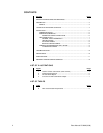
10 Pelco Manual C1926M (3/99)
2. Select a second camera that is out of synchronization with the first camera.
3. Adjust V-phase using a small Phillips screwdriver.
4. Switch the cameras back and forth, observing the “roll” between the cameras when
they are switched.
5. If roll is present, turn the potentiometer in small increments, observing the “roll” each
time an adjustment is made.
6. Repeat this process as many times as necessary and for each of the other cameras in
the system.
TROUBLESHOOTING
The following conditions may be observed when using a CCD camera and are not
necessarily a fault of the camera.
Vertical smear This may occur when viewing a bright object or an
intense reflection.
Patterned noise and blemish A fixed pattern may appear over the entire monitor
screen when the camera is operated at a high
temperature.
Jagged picture Becomes noticeable when viewing stripes, straight
lines, or similar patterns.
Camera does not operate There are no serviceable parts on MCC5600
Series cameras. If a camera fails to function
properly, confirm that all necessary connections
are in order and that lens adjustments are correct
for the application.
MAINTENANCE
Be careful not to spill water or other liquids on the unit.
Avoid operating or storing the unit in the following locations:
Extremely hot or cold places. The operating temperature of MCC5600 Series cameras
is -4° to 131°F (-20° to 55°C). Storage temperature is -13° to 158°F (-25° to 70°C).
Damp or dusty places
Where it may become exposed to rain
Locations subject to strong vibrations
Near generators of powerful electromagnetic radiation such as radio or television
transmitters
Remove dust or dirt on the surface of the lens or optical filter with a blower.
Clean the body with a dry cloth. If it is very dirty, use a cloth dampened with a small quantity
of neutral detergent, then wipe dry. Avoid the use of volatile solvents such as thinners,
benzene, alcohol, and insecticides. They may damage the surface finish, or impair the
operation of the cameras.














